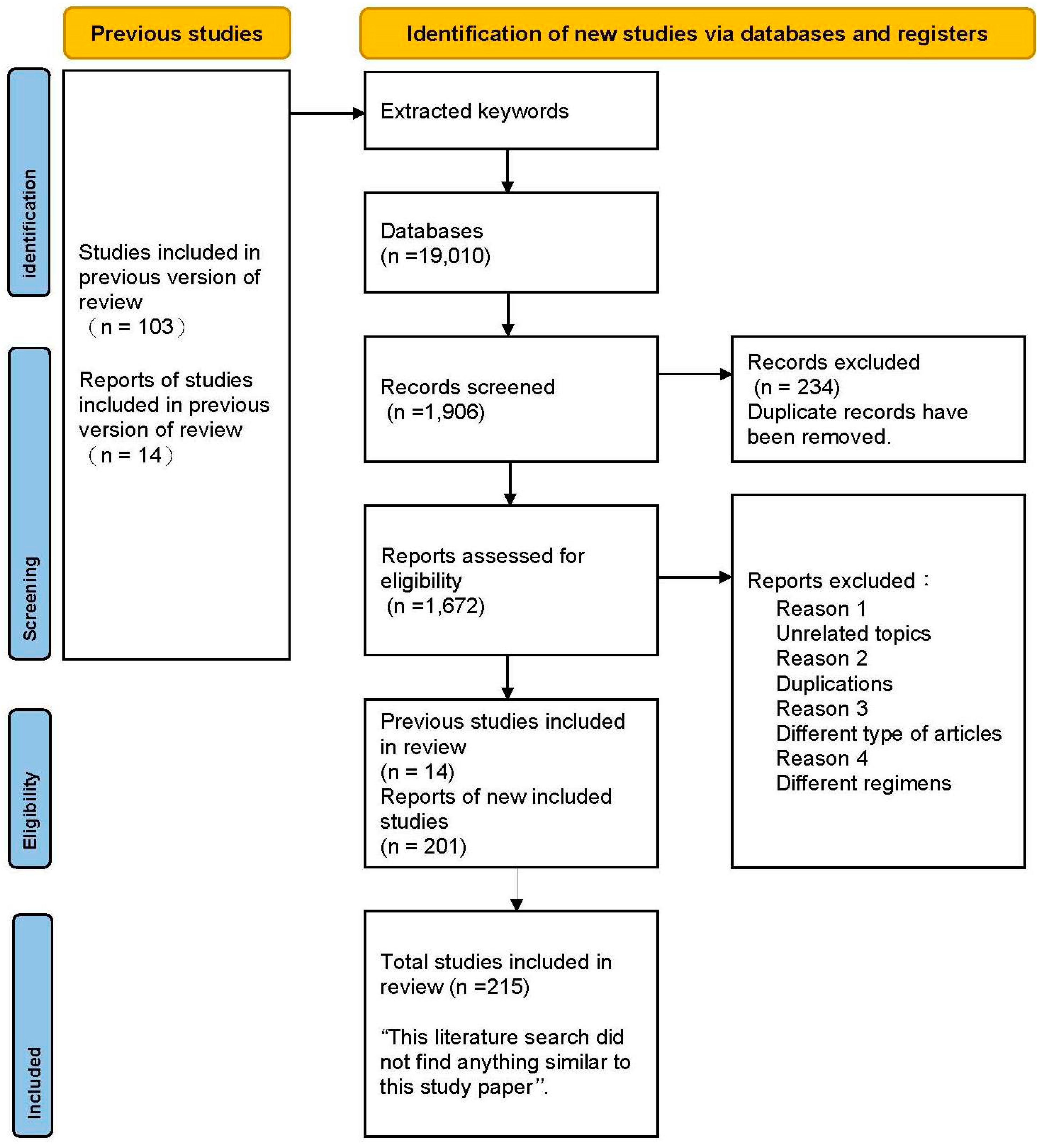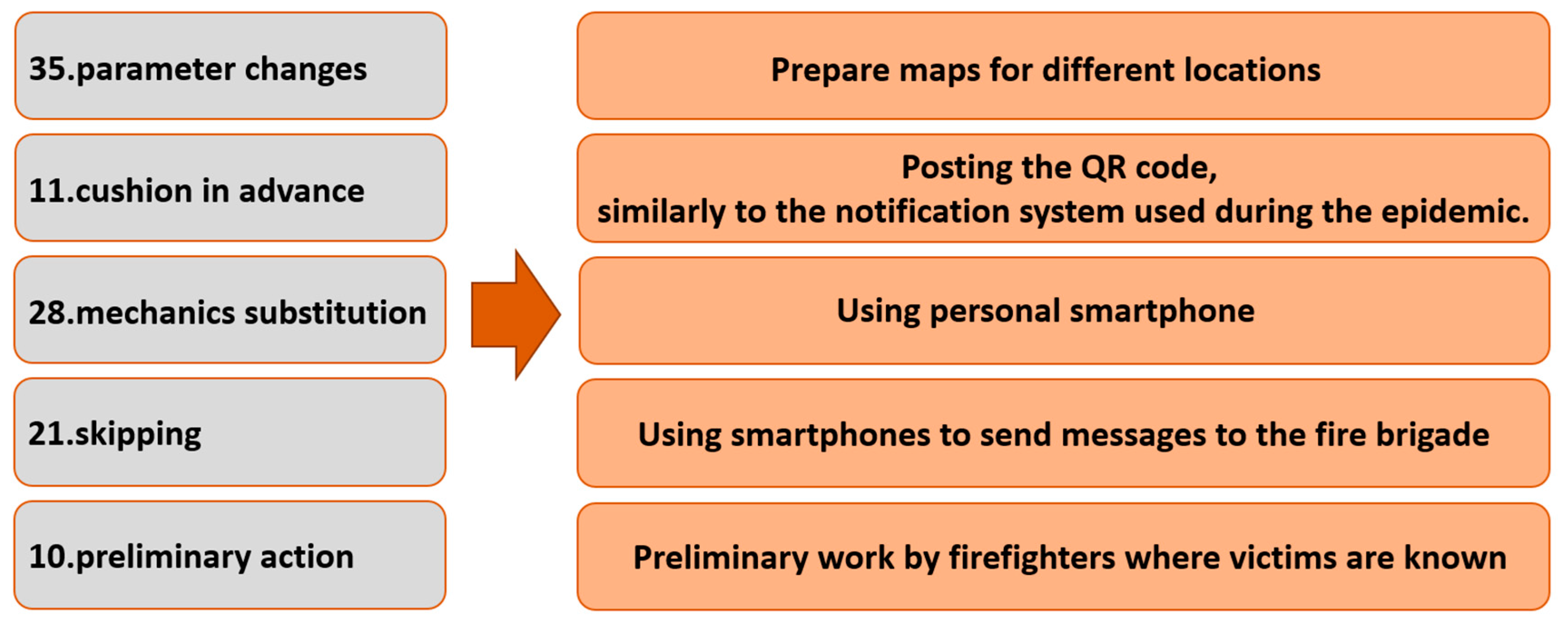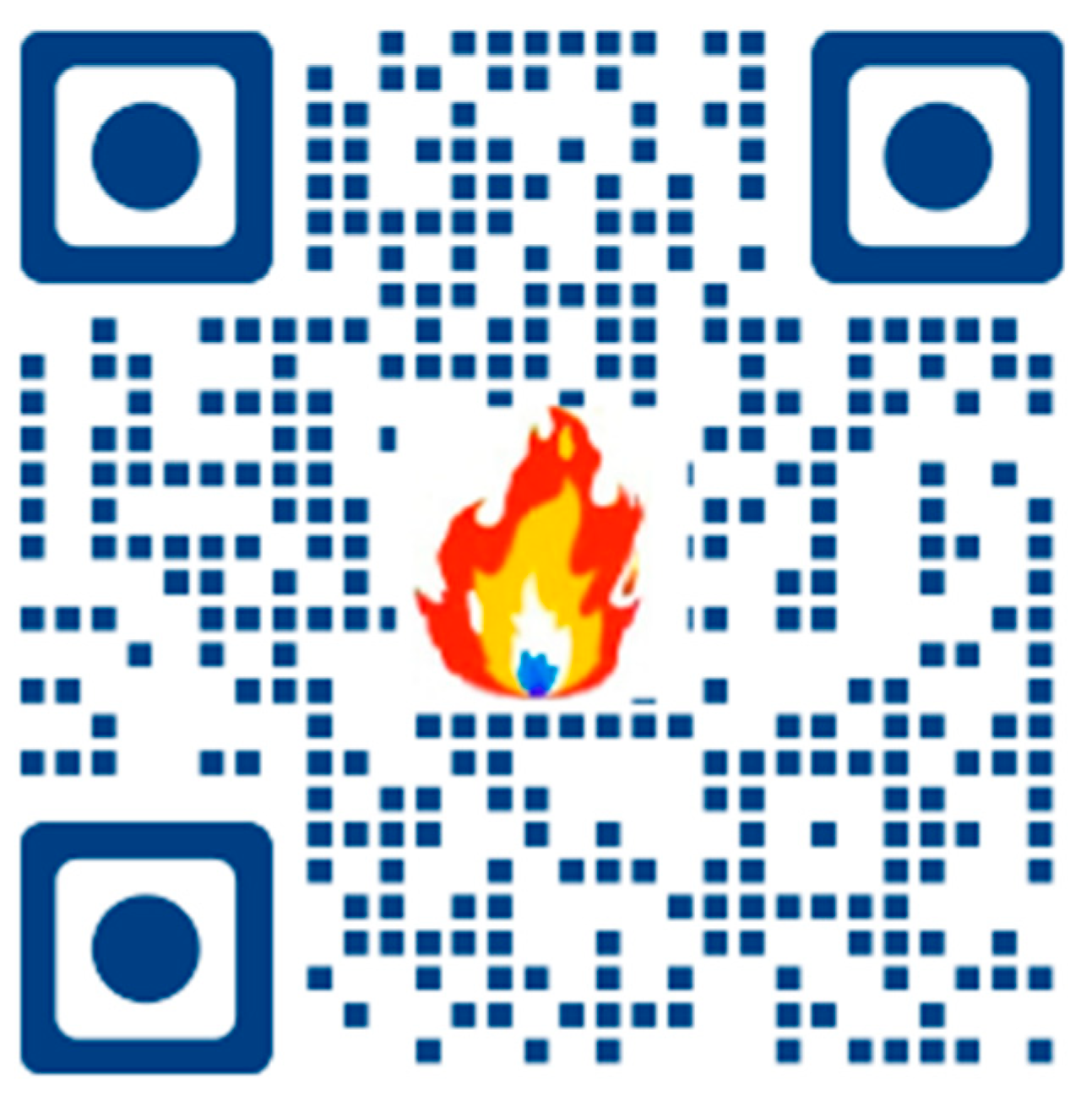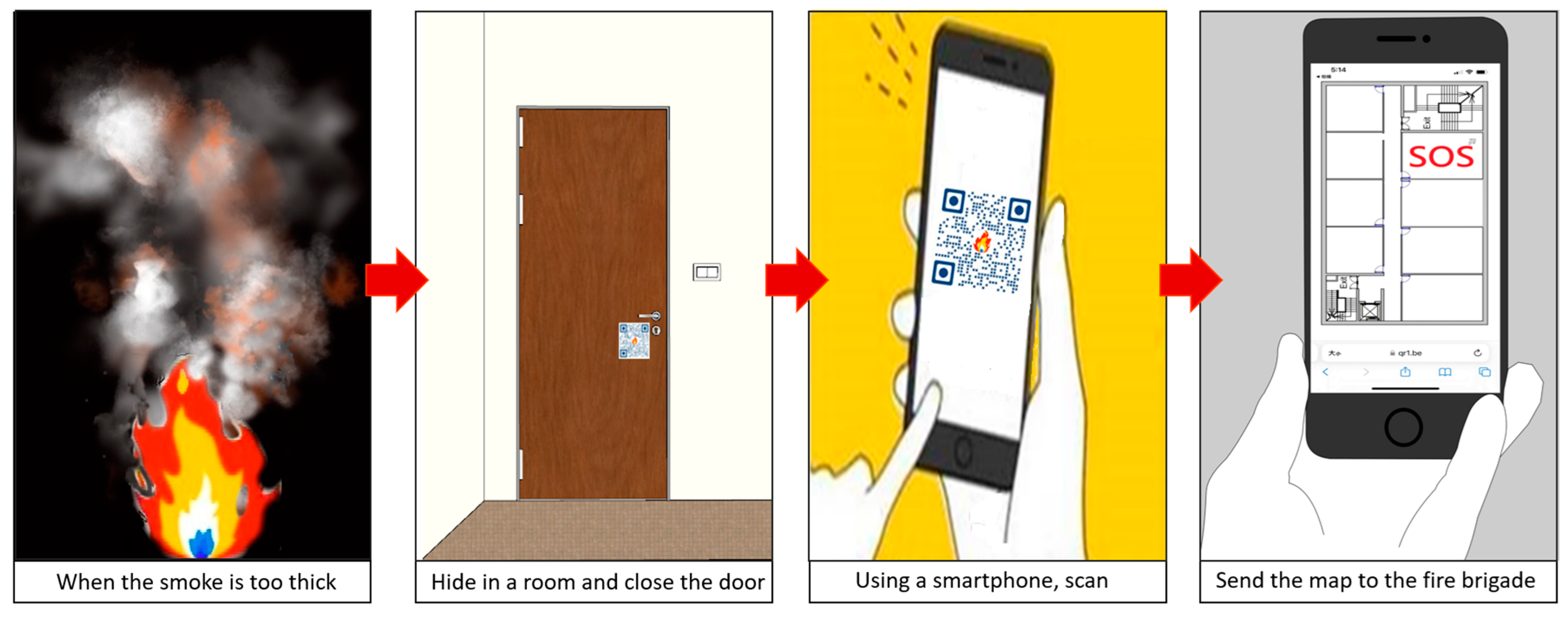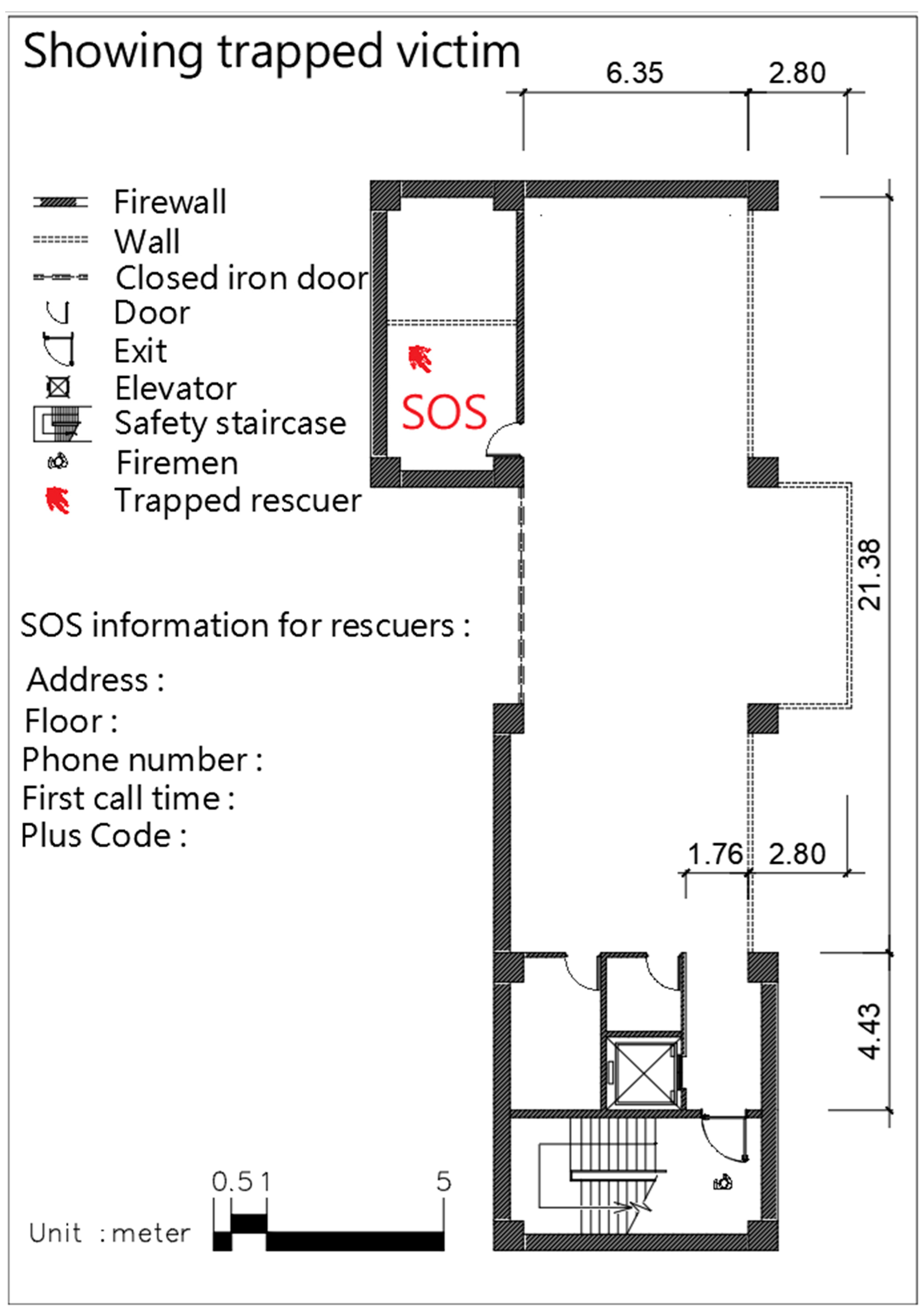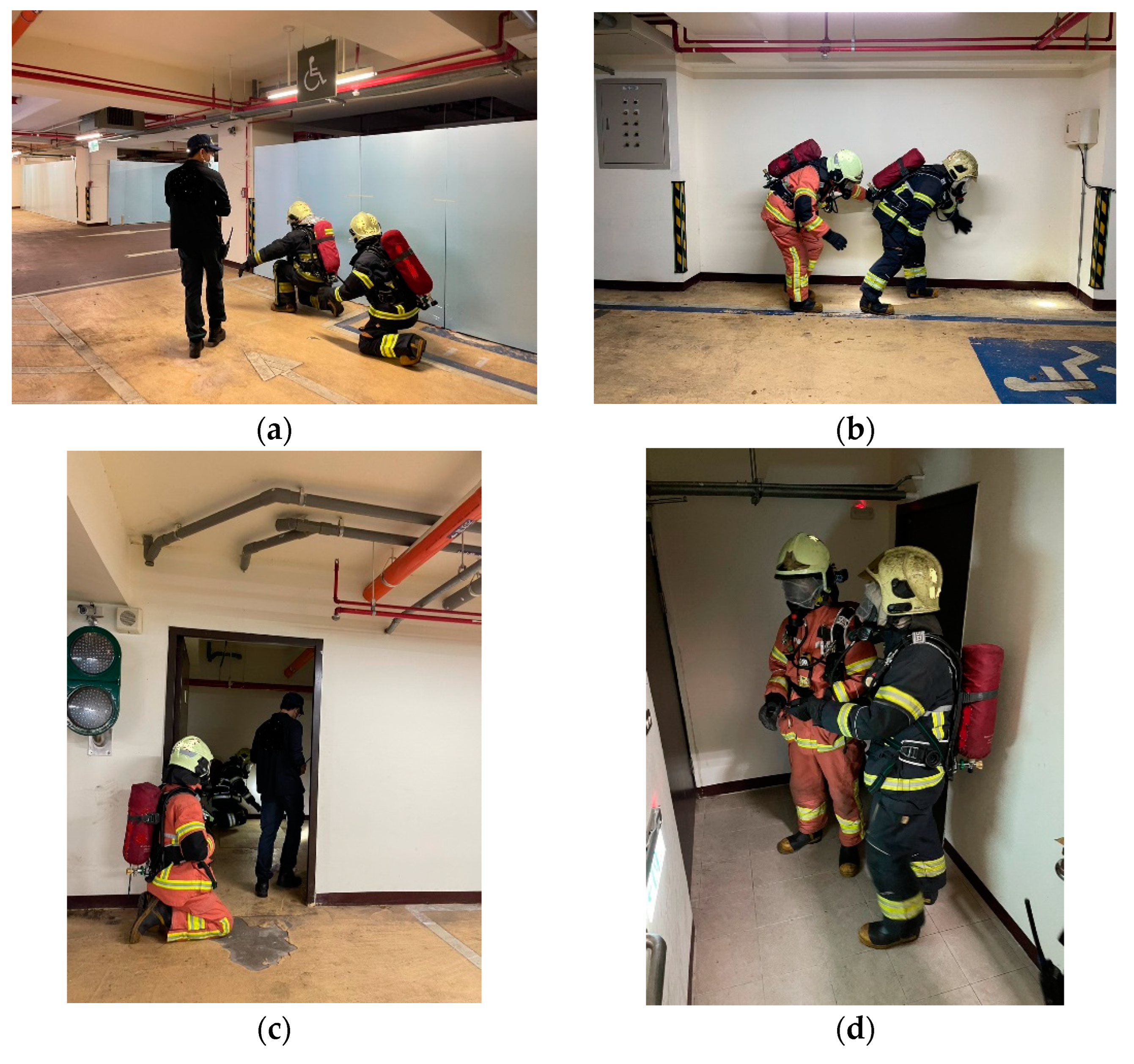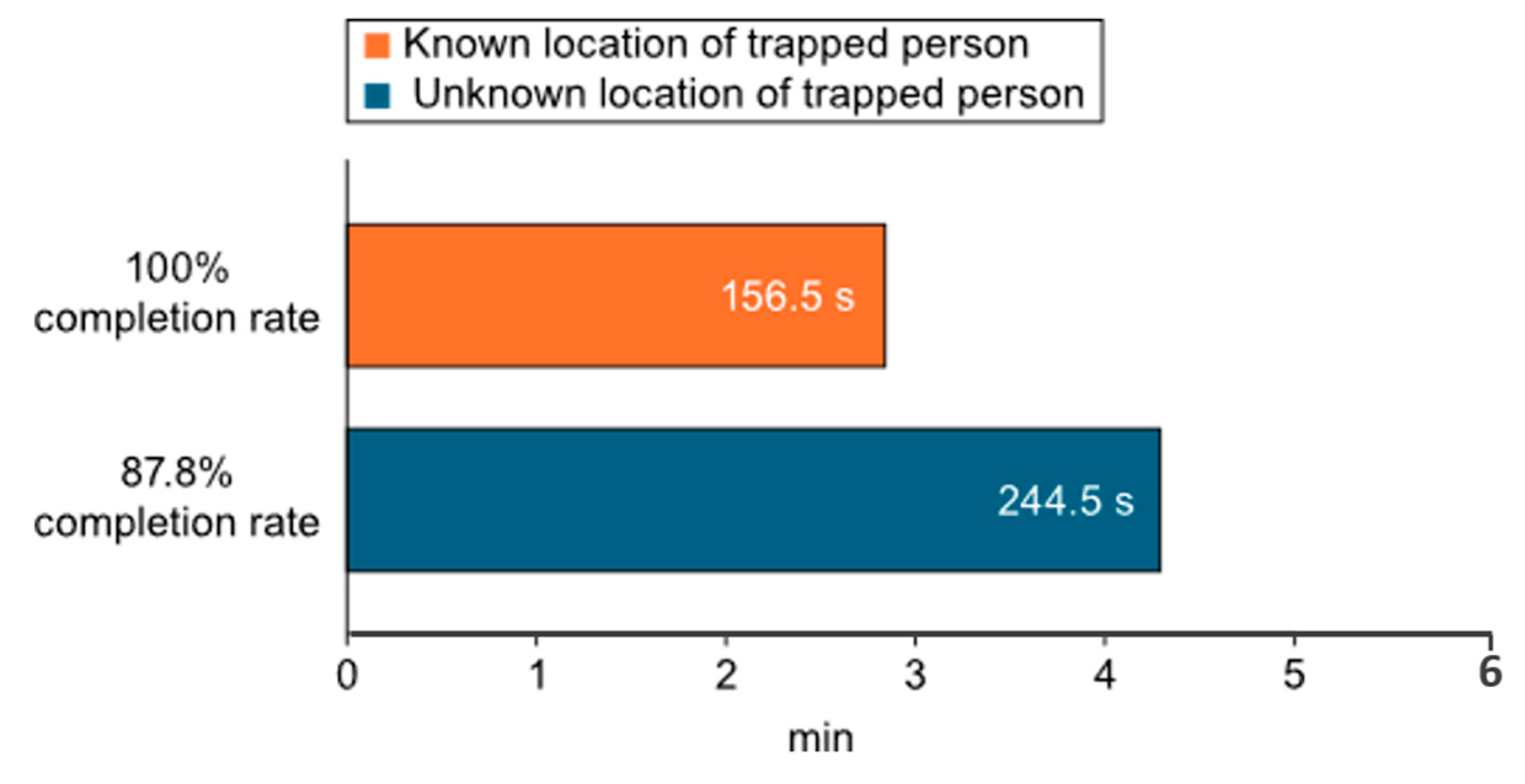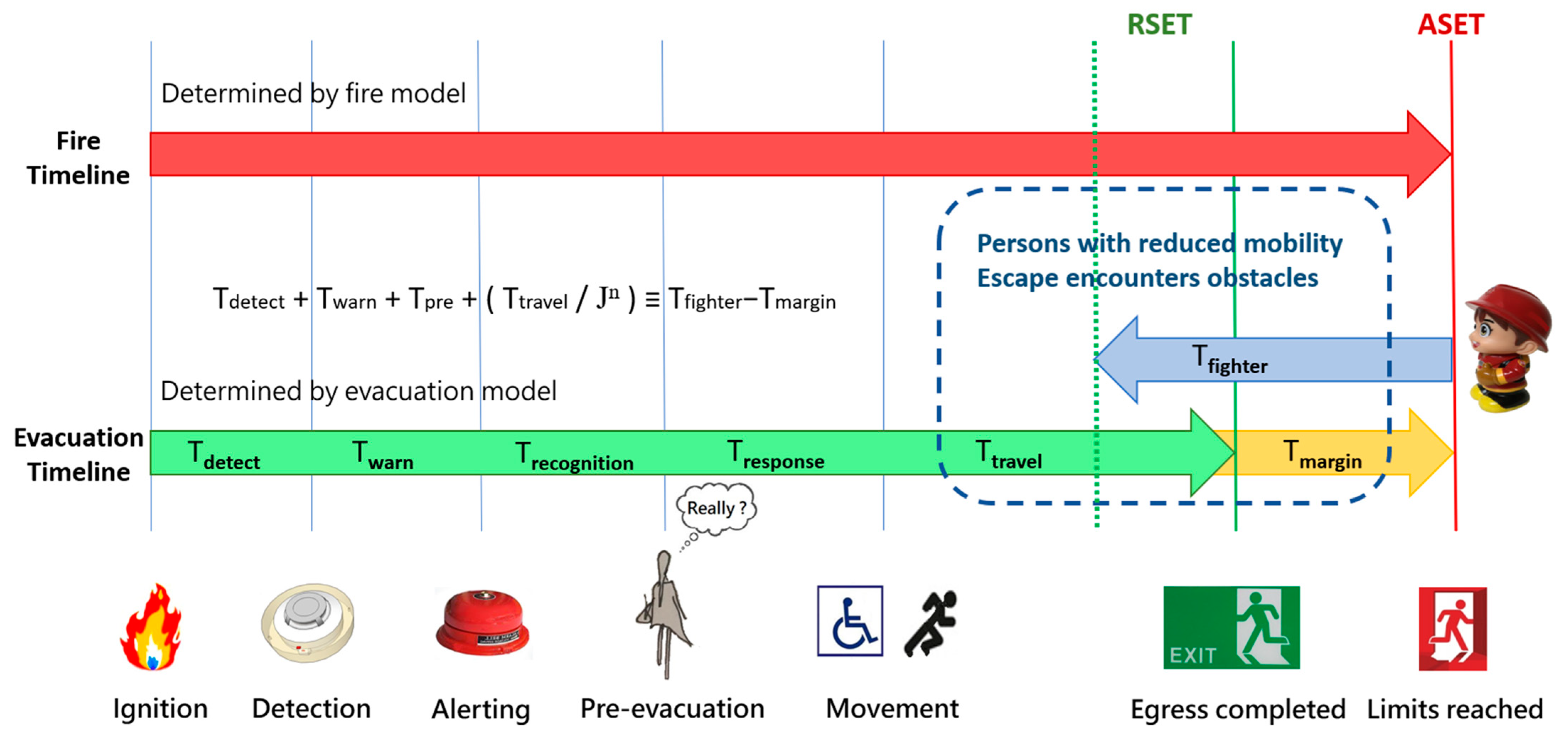1. Introduction
In the design of safety and disaster prevention indicators for smart buildings, the primary focus is typically on fire protection systems. However, whether the fundamental fire protection facilities within a building are truly sufficient to handle indoor fires remains questionable. The ability to ensure the successful evacuation or rescue of all occupants is a critical concern. Given the unpredictable nature of fire scenes, where lives can be lost in dark, smoke-filled environments within minutes or even seconds, it is crucial for firefighters to locate trapped individuals as quickly as possible. Although people can use smartphones to call for help, firefighters often find themselves entering entirely new buildings to conduct rescues and extinguish fires. Searching for trapped individuals in an unfamiliar, dark, and smoke-filled environment remains a slow and dangerous task. Therefore, when trapped individuals retreat to a specific room to wait for rescue, it is essential for building doors to be equipped with location-based emergency call functionality. These doors enable firefighters to determine the exact location of the trapped individuals, facilitating a quicker rescue from the fire scene.
Fire is the most common disaster in the built environment, causing significant economic losses and jeopardizing human safety [
1]. More and more buildings are facing over-aging problems and lack regular maintenance. These issues bring about challenges in terms of fire emergency prevention and control [
2]. It is very difficult for people to successfully escape during fires, so many people become trapped in buildings [
3]. If the escape route is blocked by smoke or fire, then occupants must make further choices about whether to continue or not [
4]. Trapped victims may be too weak to call for help, making it crucial to locate and rescue them quickly [
5]. In many cases, firefighters do not know where survivors will be. One of the challenges in search-and-rescue operations is how to locate victims [
2]. One way to reduce such hazards is to provide firefighters with timely access to accurate location information [
6]. Information about the trapped victims is an essential component of better emergency responses [
7]. Retreating to a specific room to wait for rescue is the last resort of those unable to successfully evacuate on their own. However, as of now, the indoor locations of trapped individuals still cannot be transmitted to firefighting units to inform them of the exact position of the victims. Therefore, the author identified a research opportunity to integrate a distress-signaling and location function into building materials.
Previous research has mainly focused on voluntary evacuation actions [
8], without considering the evacuation of vulnerable individuals or those stranded at the fire site due to uncertain factors. To verify the accuracy of the whereabouts of trapped individuals, thermal image cameras (TICs) have been introduced in recent years to assist search-and-rescue operations in Taiwan [
9,
10]. Due to the limitations of indoor positioning technology, rescuing individuals in smoke-filled environments remains a significant challenge. The search-and-rescue tasks of firefighters at a fire scene are generally divided into rescue operations on non-fire floors and firefighting and search tasks on fire floors. This study was limited to the investigation of search-and-rescue missions on non-fire floors. The objective of this study was to explore methods that could enable firefighters to swiftly rescue trapped individuals at fire scenes. The authors proposed an innovative “call-for-help notification system” (CFHNS). When a fire breaks out, the trapped person can scan the quick response (QR) code on the door with a smartphone, which immediately sends the coordinates of the trapped person to the firefighters, who can then identify the correct indoor location of the trapped person. Scanning QR codes has become a routine activity for anyone using a smartphone, making it highly practical for use in emergency situations. This also facilitates this method’s easier promotion and implementation by government authorities. Among the 166 firefighters who participated in the verification, 95% believed that providing the location map of the person to be rescued was effective, and 96.4% believed that it could shorten the search times. Although AI-assisted positioning systems can be utilized, their high costs make them impractical for implementation in all buildings and challenging for government adoption. In comparison, a QR-based system is more feasible and cost-effective to implement. This study has a certain degree of innovation because the scientific and technological method it presents was granted a patent certificate by the Taiwan Intellectual Property Office; therefore, it proved to be a novel search-and-rescue assistance system. The target of this scientific study is to convey new knowledge and information. After all, successful research must be not only academically reliable but also easily applicable to the relevant industry.
2. Materials and Methods
The methodology and objectives of this study are focused on finding more reliable and valid answers to the problem or identifying better solutions. To identify the current research gaps and propose innovative strategies or research concepts, we conducted a systematic review and meta-analysis (PRISMA) to identify issues related to factors influencing firefighter search-and-rescue operations. Specifically, we found a lack of technological equipment among indoor fire search personnel. Next, we used the TRIZ (Teoriya Resheniya Izobreatatelskikh Zadatch) method to determine how to design and manufacture novel assistive search devices. Finally, based on quantitative positivism, we collaborated with the fire department and invited a specific fire brigade from a certain district to participate in the experiment; we verified the use of firefighters participating in the CFHNS.
2.1. Journal Article Search Plan
The aim of this literature review was to identify new aids to improve fire search-and-rescue operations for firefighters. The author used Scopus as the main database due to its high-quality selection of articles and journals [
11].
- (1)
Search Limits
Only articles published in open-access journals were reviewed. The restricted subject categories were engineering, environmental science, computer science, and materials science.
- (2)
Search Strategy
We identified previous studies in databases using searches of related keywords [
12,
13]. The search terms involved the following equipment, technologies, etc.:
Equipment: TIC, helmet, camera, smartphone, and robot.
Technology: BIM, GIS, VR, AR, hybrid reality, AI, machine learning, games, and deep learning.
Other aspects: navigation, positioning, wayfinding, and pathfinding.
- (3)
Data Extraction
After data extraction, a total of 201 articles were included in this review via searches of fire-related keywords, which were then subjected to a category analysis using the VOS viewer, as represented in
Figure 1. The search results rely on the Scopus database search and publisher view. When downloading was not permitted, Semantic Scholar, PubMed, Google Scholar, or the database ScienceDirect were used to conduct subsequent searches. If there were missing searches or some could not be downloaded in full, sufficient results could still be obtained.
2.2. Journal Article Search Execution and Finding
PRISMA is a literature review method that is commonly used in the medical field. Using this method, a large amount of existing data can be analyzed; it is an established and reliable research method in the medical and biological professions. We employed the PRISMA methodology for the literature review, and we believe that a historical review of disaster prevention technologies is also appropriate.
A total of 1672 entries were identified from the keyword search combination, initially selected based on citation frequency. The entries were then screened by the researchers, following a sequence where titles and abstracts were reviewed first, followed by the conclusion or introduction sections. Each article was individually examined for inclusion or exclusion. Through this process, developed disaster prevention technology solutions were identified, which are detailed as follows:
A total of 1672 articles were included in the analyzed studies, as shown in
Figure 2.
- (2)
Eligibility Criteria.
For scientific papers, a H-index of over 23 is often used as a rough measure of a paper’s importance [
14,
15], as these papers proved to be the most useful to many practicing scientists.
- (3)
Study Selection.
Since Apple launched the first generation of smart mobile phones, the innovative use of smartphones has changed. Therefore, the literature search timeframe was set from 9 January 2007 to 26 June 2024.
- (4)
Risk of Bias.
Due to the choice of database and keywords, some documents were not included. This did not affect the final results of the study but may limit comparisons across studies.
- (5)
Inclusion and Exclusion Criteria
The inclusion criteria involved selecting articles that were previously cited and were related to firefighter search-and-rescue topics. The exclusion criteria included irrelevant topics, duplicate articles, articles of different types, and different regimens.
We discovered that, other than employing robots for indoor fire rescue, no technological methods exist for smoke-filled search scenarios. Finally, 215 articles were selected for review according to the PRISMA guidelines.
Thereafter, we identified the keywords to determine the key factors. We then used these keywords to address the critical issues and constraints, including speed, time loss, and reliability. Next, we used the TRIZ method to identify the key factors influencing the success of rescuing trapped individuals (e.g., codes 4, 10, 11, 21, 27, 28, 30, and 35, as shown in
Table 1) and designed a door panel with an emergency call functionality to address these issues.
TRIZ provides a methodology for engineering creativity [
16,
17,
18]. Using the theory of inventive problem solving (TRIZ), with its contradiction matrix technology and forty invention principles [
19,
20], we can define a reliable answer [
21,
22]. We took the three most important parameters of a multiple contradictions query with a matrix: speed, loss of time, and reliability.
Navigation is the most common use of mobile maps [
23]. If trapped individuals can send a location map to firefighters, they will be rescued more quickly. Therefore, a medium to represent the map is needed. A QR code can serve as the map and can be transmitted using a mobile phone. Thus, integrating a QR code into the door panel represents a practical smart building solution. The procedure for this solution is illustrated in
Figure 3.
2.3. Experimental Design
After the COVID-19 outbreak occurred during the study period, the Taiwanese government stipulated that a QR code needed to be scanned using a smartphone to enter and exit public places. If an infected person entered or exited an indoor space, the government could quickly determine who was likely to be infected and manage this via notifications. Therefore, since the action of scanning a QR code with a smartphone is already familiar in Taiwan, we used this technology for our experiments [
24,
25]. We utilized open-source software to create an indoor map and convert it into a QR code, as shown in
Figure 4.
This study aims to be applicable to real-life situations. Therefore, with the assistance of the fire department, we set up a facility for the researchers to conduct the experiment. Based on the provided site, we created an indoor map and then used open-source software to convert the floor plan into a QR code. In future practical scenarios, the fire department will need to provide the platform for converting floor plans into QR codes. The map was drawn using the method used to draw Taiwan’s annual fire safety declaration map. The instructions were as follows: Print this QR code, paste it on the door, scan it with your smartphone, and send it to a firefighter for confirmation. This process is shown in
Figure 5.
We selected a fire department from a region in Taiwan for this study. Although only 166 firefighters participated in the experiment, this number exceeds the typical number of responders deployed to a single fire incident. Furthermore, this represents a staged training cohort. In this four-day field experiment, the participating firefighters were divided into a treatment group and a control group each day.
This case pertains to a research project involving human behavior in Taiwan: specifically, the Experimental Plan on Minimal Risks. It was submitted to the Northern District Alliance for ethical review and is on record as being compliant with regulations. In studies involving human participants, the researchers declare that they obtained informed consent from all participants involved in the experimental research, with the consent provided via paper questionnaires.
The experimental design outlined above is based on the ’Journal Article Search Plan’ and the ’Execution and Discovery of Journal Articles’. Appropriate parameters were identified from TRIZ’s List of 39 Features. Then, using the TRIZ contradiction matrix, key inspiration keywords were discovered, which, through associative thinking within the framework of design thinking, lead to solutions. Finally, a plan was developed to design and conduct the experiment.
3. Experiments and Results
Research and development present a challenge that must be addressed in applied sciences. In the field of smart building technology for disaster prevention, extensive literature reviews have been conducted to identify research gaps. Using the TRIZ matrix technique, a theory for innovative invention, we aimed to determine the key methods required to locate trapped individuals in a fire scene. The next step involved evaluating how to verify the feasibility of these methods and ensure that they can be adopted and implemented by the relevant government departments.
The primary purpose of a comprehensive literature review is to identify the most promising innovative research focus and to conduct a preliminary feasibility assessment. This is because the more thoroughly and deeply we understand specific background knowledge, the more comprehensive and meticulous our critical thinking about the problem will be. Using a systematic PRISMA article review, we found that firefighters lacked the scientific and technological skills to determine the locations of trapped people. At present, other than TICs and robots, there does not seem to be a faster way to assist firefighters in searching for victims in an indoor fire scene; TICs and robots were shown to be ineffective in quickly and effectively rescuing trapped individuals. By reviewing the articles retrieved from PRISMA, we identified three parameters for worsening features and improving features (speed, time, and reliability) from the 39 engineering parameters in TRIZ. These parameters correspond to 5 of the 40 inventive principles in TRIZ. We further developed our design and determined technical solutions to these problems. Finally, the CFHNS was manufactured. Simply put, this involved designing
Figure 4 step by step based on the information presented in
Table 1 and
Figure 3. After implementing the door panel with an emergency call functionality, the authors invited firefighters to test the system in real-life scenarios. The aim was to verify whether this solution could shorten rescue times.
After an experiment conducted by the fire department, we found that the CFHNS improved rescue efficiency. In an actual building fire, this notification system may reduce the number of casualties. Smartphones can be used to send distress signals and provide search information to firefighters during an indoor fire. This ensures that the research results not only have academic depth but also show practical applicability in the industry. The study was designed to obtain creative solutions for search-and-rescue operations in indoor fires using design thinking. The CFHNS obtained a new type of patent certificate provided by the Intellectual Property Office of the Taiwan region of China. The patent certificate number is TWM625231U. The purpose of applying for the patent was to demonstrate that the work contains no plagiarism or theft of others’ work. There is no intention to monopolize or sell the intellectual property rights. We hope that this system will be widely utilized by various sectors. In the realm of architectural disaster prevention technology within the discipline of fire engineering, it is necessary to discuss how to use new technology in rescue scenarios. With the assistance of new technology, firefighters can save people and put out fires more quickly.
3.1. Implementation of Experiments
This research focused on exploring techniques that could enable firefighters to rapidly rescue individuals trapped in fire situations. Therefore, open-source software was used to create a quick response code representing a map of the experimental location, as shown in
Figure 6, which was posted around the door handle to facilitate use during emergency calls. For safety reasons, smoke was not used in the fire simulation environment to facilitate the observation and recording of the time required for participants to search for individuals. However, the visors of the participants’ helmets were covered with opaque film to simulate the visual obstruction caused by smoke in a fire scenario. Each firefighter participating in the experiment was equipped with full rescue mission attire and gear to ensure the reliability of the practical test and the realism of the simulation. The experimental site was designed by the authors, and the standard search paths established for the experiment were consistent. In other words, whether the search was conducted in a clockwise or counterclockwise direction, the distance of the path remained the same, adhering to a uniform indoor carpeted search pattern.
3.2. Participants
During the search task experiment, 10 participants abandoned the mission. The study’s findings are limited to the 156 participants who undertook routine training with the fire brigade. This was their first time entering the designed experimental space. We conducted two experiments, in which participants were divided into those who did not know the location of the victim and those who knew the location of the victim. The participants were all dressed in standard firefighter gear, i.e., thermal protective clothing (TPC) and a self-contained breathing apparatus (SCBA), and they put on fuzzy masks to simulate the visual appearance of the dense smoke space.
According to the reference “THE CONCEPT OF DEATH”, certain cells in the midbrain and brainstem can survive for up to fifteen minutes under hypoxic conditions, while brain cells cannot withstand oxygen deprivation for more than six minutes. If cardiac arrest lasts for eight to ten minutes or longer, brain death occurs. Therefore, the search time for each group was limited to six minutes. Due to ethical considerations, if we found that a participant’s hand was caught in the door, or if the participant started searching aimlessly or circling in the dark smoke, we had to request that the group abandon the search task.
3.3. Test Research Hypotheses
Currently, there are no breakthrough solutions for searching for trapped individuals during indoor fires. This research gap exists due to a lack of interdisciplinary approaches and integration with advanced technologies in previous studies. In a fire scene with smoke, when people are waiting for rescue behind a closed door, the smoke generally does not reach a height of 180 cm. Based on this logical and well-founded assumption, the scanning of a quick response code posted on the door handle with a mobile phone is expected to be executed correctly.
Additionally, we hypothesize that providing firefighters with a map indicating the locations of trapped individuals, as opposed to a map without such markers, will enable a faster search for the individuals trapped during a fire. The experimental results confirmed this. The map with trapped individuals’ locations is shown in
Figure 7. As this experiment demonstrates that providing firefighters with such location maps shortens the time needed to find the trapped individuals, the authors predict that this approach could significantly improve survival chances in fire situations.
In the third step of the diagram in
Figure 5, a test QR code is shown. Anyone can scan it with their mobile phone to display a map. This map accurately represents the person’s current location, and different doors can have unique QR codes attached, which can be used for emergency rescue or to provide information about the location of the door. In other words, this represents a door panel made from smart building materials.
Maps are a low-threshold tool for understanding one’s surroundings, providing a visual representation of the geographical aspects of the location [
26]. The two floor plans depicted in
Figure 6 and
Figure 7 represent the actual layout of the space. The designated search area for the experiment needed to align with the timing of each routine training session. Therefore, the authors controlled the size of the experimental site to fit within these constraints, rather than utilizing the entire floor area.
3.4. Experimental Procedure
It is common for firefighters to crawl when searching in a hot and smoke-filled environment [
27,
28], following the standard procedure of searching every corner of all rooms. Firefighters from various districts participated in an experiment in which they searched for a dummy model in need of rescue during a simulated fire. The experiment was conducted over four consecutive days, with participants divided into two groups each day. The experimental site was specially designed, ensuring that no firefighter had previously entered the area. One group was informed of the victim’s location, while the other group was not. The difference in search times between these groups represents the data that the researchers aimed to analyze. During general search training, even if a floor plan is provided, the location of the person to be rescued is unknown. In this experiment, a clear map of the location of the person to be rescued was added. The researchers observed the two experiments, and the firefighting instructors also maintained their safety, as indicated in
Figure 8.
In the first experimental group, participants were required to look at a floor plan without victims, as illustrated in
Figure 6. The firefighters simulated blindly searching for trapped individuals in dark and unclear spaces. However, in an actual indoor fire incident, it is possible that a floor plan of the location may not be available during the search for trapped individuals.
In another experiment group, participants were required to look at a floor plan that displayed a trapped person, which is illustrated in
Figure 7. The firefighters simulated searching for trapped individuals in a dark, smoke-filled environment, with the trapped individuals already positioned at specific locations.
In both experiments, the search times for each group of participants were recorded until the trapped person was found or the search was abandoned.
3.5. Analysis of Data and Results
The timing of indoor fire incidents, the purpose of the building, the proximity to the fire brigade, the number of individuals, the age of the people, and their personal physical fitness affected the rescue time. In this field experiment, the authors compared the differences in results by manipulating one “variable”, specifically, the availability of the victim location information on the floor plan. The group in which the independent variable was manipulated is the experimental group, which had access to the victim location information. The group where the independent variable remained unchanged is the control group, in which participants did not have access to the victim location information; this represents the typical scenario in firefighting rescue operations.
A total of 41 teams undertook the rescue without knowing the location of the trapped person, and 36 of them completed the search task. It took an average of 258 s (4 min 18 s) to find the trapped person, excluding five teams (a total of 10 people) that were unable to discover the trapped person and abandoned the search mission, which accounts for over 12%. The researchers observed that the main reason for the abandonment of tasks by the five teams was failure to perform basic search training techniques properly, which resulted in their inability to locate the trapped individuals. Some even struggled to recognize door handles or door panels. Due to continuously circling the area and lacking patience, they ultimately decided to abandon the task. In actual fire rescue operations, it is possible for a search to be abandoned. The actual proportion of such cases cannot be estimated, resulting in a more pronounced difference. Due to the exclusion of the search times of participants who abandoned the task, we can only compare the time taken to complete the search task between two groups. This limitation is one of the constraints of our study.
The Shapiro–Wilk test was performed to assess whether the data in the control group followed a normal distribution. The test statistic was 0.9518 with a p-value of 0.1188. Since the p-value is greater than the significance level of 0.05, we failed to reject the null hypothesis, suggesting that the data in the control group are consistent with a normal distribution. The sample size of the control group is 36, which is greater than 30; the z-distribution was used to calculate the confidence interval.
The confidence interval for the control group (235.45, 280.33) indicates that the true population mean is likely to fall within this range, with 95% confidence. A total of 42 teams completed the search mission knowing the position of the trapped person. It took them an average of 171 s (2 min 51 s) to find the trapped person. Knowing the location of the trapped person led to faster rescues than not knowing the location of the trapped person.
For the experimental group, the Shapiro–Wilk test yielded a test statistic of 0.9501 and a p-value of 0.0654. As the p-value exceeds 0.05, the null hypothesis of normality cannot be rejected. Thus, the data in the experimental group are also likely to follow a normal distribution. The sample size of the control group was 42, which is greater than 30; the z-distribution was used to calculate the confidence interval. The confidence interval for the experimental group (149.31, 191.60) suggests that the true population mean for this group was also captured within this range with 95% confidence.
Notably, the confidence intervals for the two groups do not overlap, providing strong evidence of a difference in the population means. The experimental group’s time was 1 min and 27 s faster than the control group, representing a shortening of the search time by 33.72%. According to estimates, the use of a “call-for-help notification system” in buildings can reduce search time by at least one-third.
The descriptive statistics In terms of the mean, median, standard deviation, maximum, and minimum are as follows: the averages were 170.45 and 257.89 and the medians were 156.50 and 244.50, and all exhibited a slight positive skew distribution. The standard deviations were 69.91 and 68.70. The maximum values were 371 and 405, and the minimum values were 56 and 140. To test the equality of variances, Levene’s test was performed. The F-test obtained
p = 0.609 > 0.05, and the correction was made using Welch’s
t-test (
Table 2). This indicates a significant difference in the means of the two groups for
p = 4.03 × 10
−7 < 0.05. The mean difference between the two groups was 87.44, with confidence intervals supporting this significant difference. These results should demonstrate that knowing the location of the trapped individuals significantly reduces the time firefighters need to find and rescue them.
However, conducting search operations within a confined space in the simulation laboratory has demonstrated that, even in small areas, search times can be reduced. Therefore, it is logical to infer that larger spatial areas would further shorten the search times, as evidenced in
Figure 9.
Currently, the total number of firefighters in New Taipei City is 2436. For a 95% confidence level with a 5% margin of error, a sample size of 332 participants is required. For a 3% margin of error, the sample size needs to be 743 participants. Although the sample size in this experiment was only 166, a reliability coefficient (Cronbach’s alpha) of at least 0.80 is generally accepted in basic research. The Cronbach’s alpha for this study is 0.8025, indicating good reliability.
3.6. Discovery of Rescue Time
Through the firefighting efforts and search-and-rescue operations conducted by fire personnel, evacuation times can be extended, and the number of casualties reduced. A smartphone voice-guided evacuation system (SVGES) is a previously studied device that can provide active escape guidance during an indoor fire; operating the system in reverse allows firefighters to reach victims. However, of electronic route signs (ERSs) are destroyed by fire [
8,
29], this system may suffer from fire damage, making firefighters unable to navigate forward. Nonetheless, the results of this study take advantage of a new technology that can assist firefighters in their search-and-rescue missions. Although this technology is not complicated, thus far, it has not been practically implemented in any countries around the world.
In general, researchers focus on the relationship between the available safety egress time (ASET) and the required safety egress time (RSET) [
8,
30,
31,
32,
33], whereas an acceptable margin of safety time is not considered. Therefore, it should be possible to rewrite the engineering and survival timelines [
34,
35,
36,
37] with the addition of the items of rescue waiting time and firefighter search time [
38], as indicated in
Figure 10. Because the survival rate is inversely proportional to the waiting time for rescue, the mathematical formulae can be rewritten as Equations (1) and (2):
ASET: Available safe egress time.
RSET: Required safety escape time.
Tfighter: Search time required for firefighters to rescue trapped victims.
Tdetect: Fire detector detection time.
Twarn: Fire alarm activation time (warning time).
Tpre: Recognition time and response time (pre-evacuation time).
Ttravel: Evacuation time (travel time).
Tmargin: An acceptable margin of safety.
n: Number of turn nodes on the escape path (n > 0).
J: Correct path node direction (if correct = 1; otherwise, 0).
In summary, we observed that, when nodes (j) appear along the search path, firefighters need to perform searches to the left or right. As the number of nodes (n) increases, this is mathematically represented by a square operation. The authors found that the same principle applies to the choice of escape path during evacuation. Therefore, the escape time formula described above should divide the travel time value by j raised to the power of n, as detailed in Equation (2).
Due to human panic during indoor fires and a lack of clarity about the environment, individuals are often unable to accurately identify the nearest safe exit or the best evacuation route. They may also be unaware of the lethal concentration of toxic smoke they have inhaled. Furthermore, it remains uncertain whether following the escape route of other evacuees is the correct choice. Given the complex scenarios of real fires, retreating to a room and waiting for rescue is often the safer option. During an indoor fire, unless one is certain of reaching a safe escape route to the ground floor as quickly as possible, it is generally advisable, as noted by the fire department, to retreat to a room and wait for rescue. As shown in the mathematical formula and
Figure 9, if firefighters can intervene more quickly, the chances of rescue are greatly improved. Once the trapped person’s location is known, the next step is to trust the professional firefighters to conduct the rescue.
4. Discussion
According to the average statistics from the fire department in the Taiwan region of China, firefighters die in indoor fires every year. For this reason, in 2019, the Taiwan Government amended the Fire Services Act to give firefighters the right to retreat without entering a burning building during search-and-rescue operations. The fundamental reason for this decision is that the locations and presence of trapped people at the scene of a fire may remain unclear. Whether faced with fire or smoke, it is still dangerous for firefighters wearing fiber-optic rescue signal life jackets to rush into a blaze because the extent of the fire and the location of trapped individuals may remain unknown [
39]. However, pressure can be created by public opinion and superior officials, and fire site commanders may still order firefighters to enter a burning building during disaster relief efforts and later regret their decisions. Therefore, the ability of those trapped in the fire to call firefighters for help is the most important factor in successful search-and-rescue operations.
4.1. Study Limitations and Alternatives
Unfortunately, although disadvantaged groups may also face fire hazards, people with physical and mental disabilities who are unable to use smartphones cannot be considered in this study; however, an increasing number of people wear or implant biometric and medical sensors with wireless interfaces. This means that, using a wrist band, heart monitor, long-term implantable continuous glucose monitor, a smartphone could be wirelessly interconnected to form a wireless body area network [
40]. This could form another research direction or development technology. One key principle of retreating to a specific room to wait for rescue is to do so before the smoke becomes overwhelming and affects breathing. Then, tape should be applied to the door to prevent smoke from entering the room [
41]. This increases the chances of being found and successfully rescued.
Since the experimental scenario was simple, it posed a lower risk of injury to participants. However, it lacks the realism of an actual fire scene. Therefore, it is recommended that future firefighter training exercises include obstacles, partitions, smoke, and background fire sounds to enhance the realism of rescue tasks.
This study is based on a QR code system, which has limitations. For example, it can only be interacted with by users who have smartphones. Additionally, the transmission of smartphone signals indoors relies on the availability of indoor signal equipment and wiring that has not been damaged by fire. Therefore, the best option in such situations is to seek shelter in a room with access to outdoor light and wait for rescue, as this ensures the smartphone can still receive signals through the building from external sources.
4.2. Implications and Application Issues of the Study
In the era of the internet, design thinking does not necessarily require sophisticated technology [
42]. We do not have to rely on expensive indoor positioning equipment to solve problems. Disaster prevention technology should not mean adding expensive equipment to achieve disaster prevention. We need cheap disaster prevention technology to protect human life and construct smart buildings for a better future.
Currently, it is necessary to build very expensive indoor positioning software and hardware. Making this software and hardware standard is unrealistic and they cannot be popularized in the market; therefore, finding a suitable solution is urgent. A QR code can be designed and posted by an architect when applying for the annual public safety declaration and can be annually updated and corrected. Fire departments are responsible for map database management and information security management. In addition to being used for fires, emergency systems can also be used for earthquake disasters or other emergencies.
4.3. Feasibility of Practical Implementation
The rapid urbanization process seen over the last century has fundamentally changed the way we live and interact with each other [
43]. For people to work or live in a smart building, it is necessary to use science and technology to prevent indoor fires that may endanger public safety.
The practical implementation of the above patent was authorized by the author (inventor) by the New Taipei City Fire Department for trial use. The follow-up promotion and implementation are subject to the Government’s budget. In addition to the publicity and the promotion of government orders, local fire departments still need to build a QR code map database and manage the information security issues obtained from storage. As for the posting of the QR code and the construction of a basic indoor location map, it is recommended that fire equipment engineers or architects are authorized to carry this out. To reduce the workload of local firefighters, periodic repair work may also be carried out during the annual safety inspection declaration.
The installation of QR codes is regarded as part of the layout of fire sign equipment, and architects or fire equipment engineers should be responsible for their installation and regular maintenance. Markers with the same specifications as flame-proof carpets or flame-proof curtains can be used, or waterproof and antifouling stickers can be created and pasted. Regular maintenance is carried out when an annual public safety inspection is declared, and the maintenance time for the QR codes of various buildings is the declaration time, in accordance with the current laws and regulations.
4.4. Status and Recommendations for Future Research
A fire alarm generally sounds earlier than an SOS call. The adoption of this call-for-help notification system (CFHNS) can help firefighters during rescue operations. Upon receiving a distress call, firefighters can quickly make their way to the scene. Although mobile phones can be used to communicate with firefighters, it is difficult for firefighters to determine the correct location of a trapped person from a description. Not every type of building has corresponding room codes or text nameplates. Additionally, firefighters who are unfamiliar with particular buildings cannot easily determine the correct positions of trapped people. Therefore, it is highly important to determine the location of victims in advance.
Thus far, firefighters can only adopt the traditional methods of comprehensive search tactics [
44,
45,
46]. In general, when a fire breaks out and independent evacuation is not an option, firefighters are already on their way to rescue those who are trapped. Firefighters can receive a map of the location of the trapped people while in the fire truck traveling to the scene, and this is conducive to the deployment of firefighters to prepare for search-and-rescue operations.
Although dense smoke in a fire scene may hinder smartphones from scanning QR codes at a distance [
40], using the smartphone’s flashlight to illuminate and scan QR codes at close range is a different matter. Furthermore, we cannot overlook any feasible rescue solutions for implementation. However, this study comprises a literature review and patent application, and its results demonstrate originality. We hope that follow-up research will induce more firefighters to carry out rescue operations in a simulation fire space to demonstrate the technique’s effect and provide clues for improvement. If firefighters knew the exact locations of trapped individuals, it would undoubtedly shorten rescue times and reduce the risk of injury or death among firefighters. However, in an era of rapid technological advancements, there is a noticeable lack of specialized research focused on fire rescue equipment.
We should all reflect on the fact that if a scientifically developed disaster relief device cannot be made commercially profitable, we should still work hard on research and development because this scientific and technological research contributes to the sustainable development of mankind.
5. Conclusions
Based on pragmatism theory, within the domain of building disaster prevention engineering, we developed a rescue notification door panel material designed for use while waiting for rescue from a fire. This technology can reduce the search time of firefighters in dark areas during indoor fires and is expected to be officially adopted by fire departments.
This research represents one of the latest breakthroughs and technological advancements in the field of building technology for disaster prevention. Therefore, this paper could influence the way that firefighters enter fires to find trapped people, preventing firefighters from dangerously entering fire scenes to conduct a search.
On the floors where a fire originates, the fire hose used by firefighters serves as a guiding path during the search for trapped individuals at the fire scene. We propose equipping these hoses with flashing lights and UWB positioning devices. This new era of technology should make buildings smarter, especially when combined with the smartphones that we carry every day, to ensure the safety of human lives. This can be combined with previously invented SVGES and is more suitable for practical use. Vulnerable individuals are not able to escape without the assistance of others. As a principle, we recommend that such individuals wait for firefighters to come and rescue them.
The findings of this study should be integrated with the current annual fire safety reports for practical application, which would facilitate the overall implementation and future maintenance efforts. The “call-for-help notification system” undoubtedly has the potential to enhance public safety in buildings. Despite the widespread use of artificial intelligence in modern life and technology, the infrastructure for disaster prevention and mitigation technologies remains insufficient.
We identified and analyzed shortcomings in intelligent building fire protection systems. Future research efforts will focus on improving intelligent fire suppression technology.

